Archdiocesan Collaborative School

What is an Archdiocesan Collaborative School (ACS)?
An Archdiocesan Collaborative School utilizes a shared governance model that fosters unity through the collaboration of stakeholders in support of Catholic schools The model allows decisions regarding day-to-day school operations to be made at the local level, while individual schools and school administrators are supported centrally in areas such as academics, financing, fundraising/development and marketing resources.
Why Develop a New Governance Model?
Effective school governance is an important factor in the success of any school. The Blue Ribbon Committee on Catholic Schools thoroughly examined the different governance models currently operating in Catholic schools in the Archdiocese, as well as in other Catholic school systems, and concluded the following:
- Creating a first-rate school system that can plan for the future requires coordinated leadership, accountability, and the ability to implement policy consistently and broadly across all schools.
- Aspects of the current governance models, which include parish schools, interparish-regional schools, Archdiocesan schools, and independent schools, can hinder the continuity of leadership, accountability, policy-making, and long-term planning efforts.
- An alternate governance model should be developed that would facilitate collaboration and unity among the various stakeholders.
The Archdiocesan Collaborative School (ACS) Model is a hybrid of the Archdiocesan and parish models combining aspects of centralization and governance with community involvement, accountability, and decision-making at the local level.
Key Stakeholder Roles
The Archbishop is the Archdiocesan leader with authority directly related to the Catholic identity of all schools and holds reserved powers that he may delegate to the Superintendent.
Archdiocesan Catholic School Board
Advises the Archbishop and Superintendent and is responsible for ongoing strategic planning and implementation, school system policy recommendations, and consultation on development, finance, facilities, and leadership matters affecting Catholic schools.
Superintendent of Catholic Schools
Oversees the Archdiocese of Baltimore Catholic school system and is responsible for the implementation of the strategic plan, development of school system policies, and ensuring the mission of Catholic education. The Superintendent of Catholic Schools is selected by and reports to the Archbishop.
Head of School (President or Principal)
Ensures the Catholic mission as a spiritual leader of the school while also overseeing the long-term planning and day-to-day operations of the school in consultation with the School Board. The head of school is selected, mentored, evaluated and reports to the Superintendent, Department of Catholic Schools.
Canonical Representative
Represents the interests of local parishes through consultation with the head of school and attendance at school board meetings and is a champion of Catholic education. The Canonical Representative, usually a pastor, is appointed by the Archbishop.
School Board
This deliberative body, with specified jurisdiction, subject to the Archbishop’s reserved powers, oversees policies and procedures regarding finances, advancement, marketing, building and grounds, and other areas of corporate management. The inaugural School Board members are appointed by the Archbishop and thereafter are self-perpetuating.
Program Implementation
The Archbishop adopted the Blue Ribbon Committee’s recommendation concerning the Archdiocesan Collaborative School model and, in subsequent years, all Archdiocesan elementary schools will move to this model.
The Archdiocese of Baltimore initiated implementation of the Archdiocesan Collaborative School model in 2011 with 11 schools.

